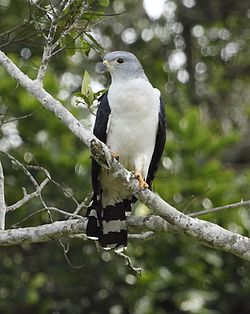This article includes a list of general references, but it lacks sufficient corresponding inline citations .(October 2015) |
| Gray-headed kite | |
|---|---|
 | |
| Adult at Restinga de Bertioga State Park in São Paulo state, Brazil | |
| Scientific classification | |
| Kingdom: | Animalia |
| Phylum: | Chordata |
| Class: | Aves |
| Order: | Accipitriformes |
| Family: | Accipitridae |
| Genus: | Leptodon |
| Species: | L. cayanensis |
| Binomial name | |
| Leptodon cayanensis (Latham, 1790) | |
| Subspecies [2] | |
| |
 | |
The gray-headed kite (Leptodon cayanensis) is a raptor found in open woodland and swamp forests. It shares the genus Leptodon with the extremely rare white-collared kite. It breeds from eastern Mexico and Trinidad south to Peru, Bolivia, Brazil and northern Argentina.


